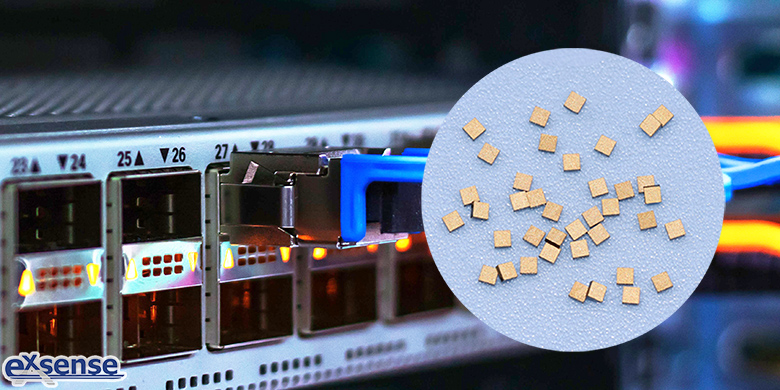
Optical transceiver NTC thermistor chip researched, developed and produced by EXSENSE Electronics Technology Co., Ltd., has the characteristics of high precision, rapid response, high sensitivity, etc., which plays the role of temperature monitoring and temperature controlling in optical transceiver. The NTC thermistor chip is installed in the optical transceiver, which can monitor the real-time temperature of the optical transceiver and ensure the normal operation of the optical transceiver.
In optical communication system, due to the different application scenarios, there are many types of optical transceivers. Letters of optical transceivers often represent industry terminology. How do we know what industry terminology the letters represent? now, by EXSENSE Electronics for you to introduce in detail.
English words such as SFP/SFP/XFP/SFP28/QSFP/QSFP28 in the optical transceiver represent the encapsulated type of the optical transceiver:
SFP represents the encapsulated type of optical transceiver below 10G;
SFP+/XFP represents the encapsulated type of 10G optical transceiver;
SFP28 represents the encapsulated type of25G/32G optical transceiver;
QSFP+ represents the encapsulated type of 40G/56G optical transceiver;
QSFP28 represents the encapsulated type of 100G optical transceiver;
The encapsulated type of the optical transceiver corresponds to the port type of the switch. Generally, SFP optical transceiver is inserted into the SFP port of the switch, and SFP28 optical transceiver is inserted into the SFP28 port of the switch, and so on.
In the name abbreviation of the optical transceiver:
SX refers to 1.25G SFP short-range optical transceiver with a transmission distance of 550 meters (transmitted using OM2 optical fiber)
SR refers to 10G SFP+ short-range optical transceiver with a transmission distance of 300 meters (transmitted using OM3 optical fiber)
The maximum transmission distance of 25G SFP28 SR multi-mode module is 100 m, the maximum transmission distance of 100G SR4 multi-mode optical module is 100 m (transmitted using OM4 optical fiber) and the maximum transmission distance of 40G SR4 has a maximum transmission is 150 m.
LX refers to 1.25G SFP medium distance optical transceiver with a transmission distance of 10km
LR refers to 10G SFP plus medium distance optical transceiver with a transmission distance of 10km
An optical transceiver with a transmission distance of 10km and a rate of 40G or 100G refers to an optical transceiver with 4*10G LR/4*25G LR.
EX refers to the 1.25G SFP long-range optical transceiver with a transmission distance of 40km
ER refers to the 10G SFP+ long-range optical module transceiver with a transmission distance of 40km
An optical transceiver with a transmission distance of 40km and a rate of 40G or 100G refers to an optical transceiver with 4*10G ER/4*25G ER.
ZX refers to 1.25G SFP ultra long-range optical transceiver, ZR refers to 10G SFP+ ultra long-range optical transceiver, the transmission distance of both is more than 80 km.
BIDI optical transceiver is a single-fiber bidirectional optical transceiver that uses WDM technology to transmit and receive two central wavelengths in different directions to realize bidirectional transmission of optical signals on a single optical fiber. TX refers to the transmitting wavelength and RX refers to the receiving wavelength.
Next, EXSENSE Electronics introduces some meanings of English letter parameters of optical transceivers:
First, the unit of wavelength of optical transceiver is nanometer (nm for name abbreviation).
Second, the unit of transmitting and receiving optical power of optical transceiver is dBm;
Third, the unit of extinction ratio is dB;
Fourth, MM refers to Multi-Mode, the center wavelength of multi-mode optical transceiver is 850nm. Multi-mode optical transceiver needs to be used with the multi-mode optical fiber (MMF) OM1/OM2/OM3/OM4/OM5. SM refers to single-mode. The central wavelength of single-mode optical module is usually 1310nm, 1330nm, and 1550nm. Single-mode optical transceiver needs to be used with a single-mode optical fiber (SMF) OS2.
Fifth, LC, SC, ST, and MPO refer to the interface types of optical transceivers. To determine the interface types of optical transceivers, need to purchase optical fiber jumpers corresponding to the connectors.
Sixth, DDM refers to digital diagnostic monitoring function; DOM refers to the digital optical monitoring function. Generally, optical transceiver has the DDM/DOM functions, which are similar. With DDM/DOM function, the network management unit can monitor various parameters of the optical transceiver in real time, such as power supply voltage, temperature, received optical power and transmitted optical power, laser bias current;
Seventh, the operating temperature of optical transceiver can be classified into commercial grade, industrial grade, and expanded grade:
The temperature range of commercial grade is 0℃~70℃, which is mainly used in indoor constant-temperature scenarios;
The temperature range of industrial grade is -40℃~85℃;
The temperature range of expanded grade is -20℃~85℃, which is mainly used in outdoor and other harsh environments (such as tunnels).
Eighth, CDR refers to the clock data recovery function. It is usually used on optical transceiver with high speed and long distance transmission. Because when the optical signal is transmitted to a certain distance, its waveform will appear to a certain degree of distortion, the signal received by the receiving end is different lengths of pulse signals, this time at the receiving end, we can not get the data we need. Therefore, it is necessary to have signal regeneration. The regeneration function of signal is re-amplification, re-shaping and re-timing. The re-timing refers to the CDR clock data recovery.
Nine, PN refers to the manufacturer's model, SN is the manufacturer's serial number.



